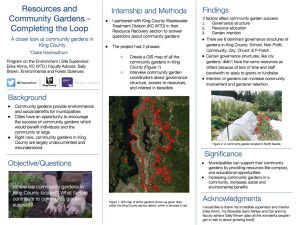Community Gardens And Resources – Completing The Loop
Community gardens provide social and environmental benefits for their greater municipalities. In King County, there is an opportunity to understand the span of community gardens better in order to support them and increase their potential community impact. The purpose of this study was to create an in-depth look or a ‘snapshot’ of community gardens within King County. The Biosolids Program situated in King County Wastewater Treatment Division (WTD) is interested in giving back to ratepayers and supporting community gardens at large. They are looking into a compost pilot which would create human waste compost or ‘biosolids.’ This product could be donated to gardens to both increase brand recognition and to provide free compost for valuable community gardens. To support this mission, I inventoried the current gardens in King County using ArcGIS. I also interviewed garden coordinators about their garden’s governance structure, resource access and intention. My work provided a general overview of community gardens in King County and provided insight into what made certain gardens successful, which included resource allocation, governance structure, and intention. These results can be used in King County and in other municipalities to provide the necessary support to allow community gardens to flourish and multiply. Gardens provide both social and environmental benefits through added green space, carbon sequestration, and food security and more. With increased support they can increase the general health and happiness of communities.
